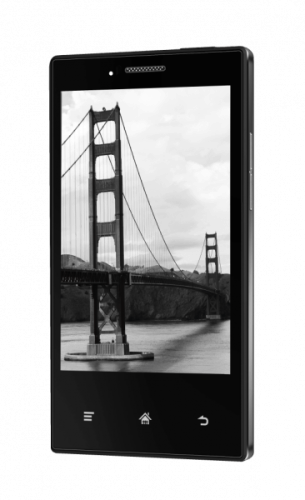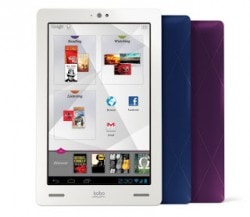The Digital Reader |
- As Booksellers Become Publishers, History Repeats Itself
- Onyx’s New E-ink Smartphone Can’t Make Phone Calls
- Budget Tablet Buying Guide: July 2014
| As Booksellers Become Publishers, History Repeats Itself Posted: 13 Jul 2014 06:28 PM PDT
This article caught my eye both for the innovating booksellers and because their innovations were once quite common. Here’s an excerpt:
And:
It’s a neat read but they missed a historical aspect which I think adds depth. There was a time when it was not unusual for a publisher to also be known as a printer and bookseller. In the early printing press era it was not unusual for someone to be known as a publisher, printer, and a bookseller. This extended into the 18th century, in fact. Benjamin Franklin is one example, and he’s not the only one. That era ended in part due to advances in printing tech which enabled economies of scale, and by improvements in transportation tech which enabled distribution. And now new technologies, both POD (printing tech) and the Internet (communication and distribution), are reviving an old idea and making it viable once again. image by Gastev The post As Booksellers Become Publishers, History Repeats Itself appeared first on The Digital Reader. |
| Onyx’s New E-ink Smartphone Can’t Make Phone Calls Posted: 13 Jul 2014 01:55 PM PDT
One early adopter is reporting that they cannot make phone calls:
That user went on to add in a follow up comment:
Some users are making calls without issue, but this is still a serious issue. An IMEI number is a unique 15 digit serial number which belongs to a specific cellphone – not just a model but a specific unit. The numbers are managed by an international body, with companies often requesting a range of IMEI numbers for certain models. Onyx neglected to register their company as a smartphone maker and request the unique serials numbers that would identify Onyx’s smartphones to telecoms around the world. This has been confirmed by other Inkphone owners , and it presents a serious issue for Onyx. As a result, Inkphone owners are at risk of their smartphone being identified as hacked, stolen, or fake by their local telecom. In short, Onyx can’t guarantee that their E-ink smartphone will function as a smartphone. Whoops. Nearly 2 years in development, the Onyx Midia Inkphone is a nifty-looking This PDA had gone up for pre-order in late June, and quickly went out of stock. Something tells me it is going to stay out of stock for quite a while. If you have an Inkphone, I would suggest that you treat it as a collectible. It’s going to be a rare commodity for quite some time. Arta Tech was queried for this post but did not respond. The post Onyx’s New E-ink Smartphone Can’t Make Phone Calls appeared first on The Digital Reader. |
| Budget Tablet Buying Guide: July 2014 Posted: 13 Jul 2014 11:29 AM PDT
There are so many tablets on the market that it is difficult to tell which ones are good; even a reviewer such as myself can’t test more than a tithe of what’s available. But as I sat here this morning, looking for a tablet to buy and review, I realized that my process for choosing a tablet included a number of rules which might be useful. Table of Contents On a related note, if you are looking for other useful info on tablets then you might be interested in the resources page I have been building (click here). On that page you will find links to the several getting started guides I have written over the years. What I’m Shopping ForIn shopping for a budget tablet, I set a hard upper price limit of $99. Anything more than that gets out of the budget market and into the same price range as the Kindle Fire HD (2013), which at $139 I do not see as a budget tablet. I also set a lower price limit of $60. As I explain below, most of the tablets that cost less than $59 do not offer a good value. As a general rule, I also avoid refurbs. Here’s a short list of the specs I want in a $99 Android tablet:
You could buy a tablet with less RAM, but that will limit its performance. You might also skimp on storage, but that’s simply not a good idea. As I and a number of other users have discovered, the tablets that ship with only 4GB internal storage fill up real quick. A microSD card will be required, and that adds to the price so I say go for the extra storage in the first place. You might notice that I insist on Google Play, but don’t mention cameras. The latter are a crap shoot for budget tablets; a tablet might have them but there’s no guarantee that the cameras will be good. And as for Google Play, most budget tablets will ship with it so you can ignore the tablets that don’t have it. They’re not even worth considering. Where I Shop for TabletsFor starters, I tend to look for tablets on three websites:
These three sites each stock quite a few models, and they also offer marketplaces where 3rd-party sellers can list items. (I’ve never encountered anyone selling tablets on Walmart.com but it could happen.) All 3 have reasonable return policies, although I have found Walmart’s procedures to be tedious. I tend to go to the tablet category and list the tablets from cheapest to most expensive.I open any potential purchase in a new tab, and I also right click on the model number and do a Google search in order to find reviews. This lets me find any truly good deals, but it also makes me have to sort through tablets I wouldn’t touch with a ten foot pole. For example, I would not buy refurbs, and I wouldn’t buy a tablet that cost less than $60. What I Won’t BuyRefurbished Tablets Most of the tablets you find in the refurb market have already been owned by at least one person, who then decided to return it. I don’t know about you but I take that as a red flag. One thing I have noticed over the years is that the worst tablets tend to show up the most in the refurb market. People buy one, realize just how terrible it is, and return it to the store. That tablet is then sold off to a 3rd-party who refurbishes it and puts it back on the market. As a rule, I won’t touch a refurbished no-name budget tablet; it’s not a safe purchase. But if I came across a name brand tablet, that’s a different matter. I would take a chance on a refurbed Amazon tablet, or a Samsung tablet. With name brands you have a better chance of getting a good tablet than you would with a no-name budget tablet. But before you buy one, be sure to check reviews. If several reviewers identify a problem then that is probably why it was returned in the first place. I would suggest that you avoid the tablet. Speaking of tablets you should avoid … Sub-$60 Android Tablets When I set out to buy a tablet this morning I intended to buy one which cost less than $60. I thought this price range offered great potential for a return on your investment, and since no one seemed to by buying the tablets and posting reviews it looked like this was a topic I didn’t have to share with other bloggers. But after a couple hours of browsing, I decided that most of the tablets weren’t worth my time. I couldn’t see myself using them, or recommending them, and so they were not worth reviewing. Most of the tablets in this price range have 3 details in common: they’re one to two years old, they run Android on single core CPUs, and their specs promise that the performance and usability will be disappointing. The sub-$60 tablets will only be about half as powerful as the $99 tablets I would suggest that you buy. They will also have poorer quality components and weaker screens. What’s more, a lot of the sub-$60 tablets I found this morning were left overs from last year and the year before, so there’s a good chance that they have aged while still in the retail box. This could lessen their lifespan. So what would I buy? I ended up buying a Hisense Sero 8 tablet, but that was mainly because no one else has posted a review. At $129, it’s outside of my price range. And due to the lack of reviews it is also an unknown, so I can’t recommend it yet. Best Tablet Value for July 2014
The Kobo Arc was initially released in 2012 as a competitor to the Kindle Fire HD. As such it was a mid-grade tablet with specs that justified its $199 price tag. Now that it costs $99, it’s a great deal. The Arc has a better quality screen than you will find on most tablets in its price range. With a screen resolution of 1280 x 800, it is both sharper and higher quality. This tablet runs Android 4.1.1 on a dual-core 1.5GHz CPU, 680MB RAM, and 32GB internal storage. There’s no Bluetooth or microSD card slot, and there is only a single 1.3MP front-facing camera (but it is a good camera). That version of Android is a little old, but this isn’t the only budget tablet running older versions of Android. And while the lack of a card slot might be a concern, I have never actually needed that much space on any of my tablets (other than the iPad, which carried a lot of enhanced textbooks). As I explained last month, the Kobo Arc is one of the two tablets I carry around. I use it as a complement to my Kindle Fire HD, which I mainly use as a media device. I have found the Arc to be perfectly satisfactory. Alas, you might not. At this time, I can only find one retailer which still carries the Arc online. Kobo sold out, and Kobo’s retail network in the US is limited and dysfunctional. But I did find the Kobo Arc at Family Christian, where you can pick one up for $99. I can’t make a guarantee that it will still be there as the weeks turn into months, but if it is available I would buy it. The post Budget Tablet Buying Guide: July 2014 appeared first on The Digital Reader. |
| You are subscribed to email updates from The Digital Reader To stop receiving these emails, you may unsubscribe now. | Email delivery powered by Google |
| Google Inc., 20 West Kinzie, Chicago IL USA 60610 | |
![360505392_69557c287d_o[1]](http://the-digital-reader.com/wp-content/uploads/2014/07/360505392_69557c287d_o1.jpg)

![Many_Tablets[1]](http://the-digital-reader.com/wp-content/uploads/2014/07/Many_Tablets1.jpg)
 If you want a safe tablet purchase for under $100, I would go for the Kobo Arc (2012). This is probably not the only good value for $99, but it is one I have had my hands on and can recommend without concern.
If you want a safe tablet purchase for under $100, I would go for the Kobo Arc (2012). This is probably not the only good value for $99, but it is one I have had my hands on and can recommend without concern.
No comments:
Post a Comment